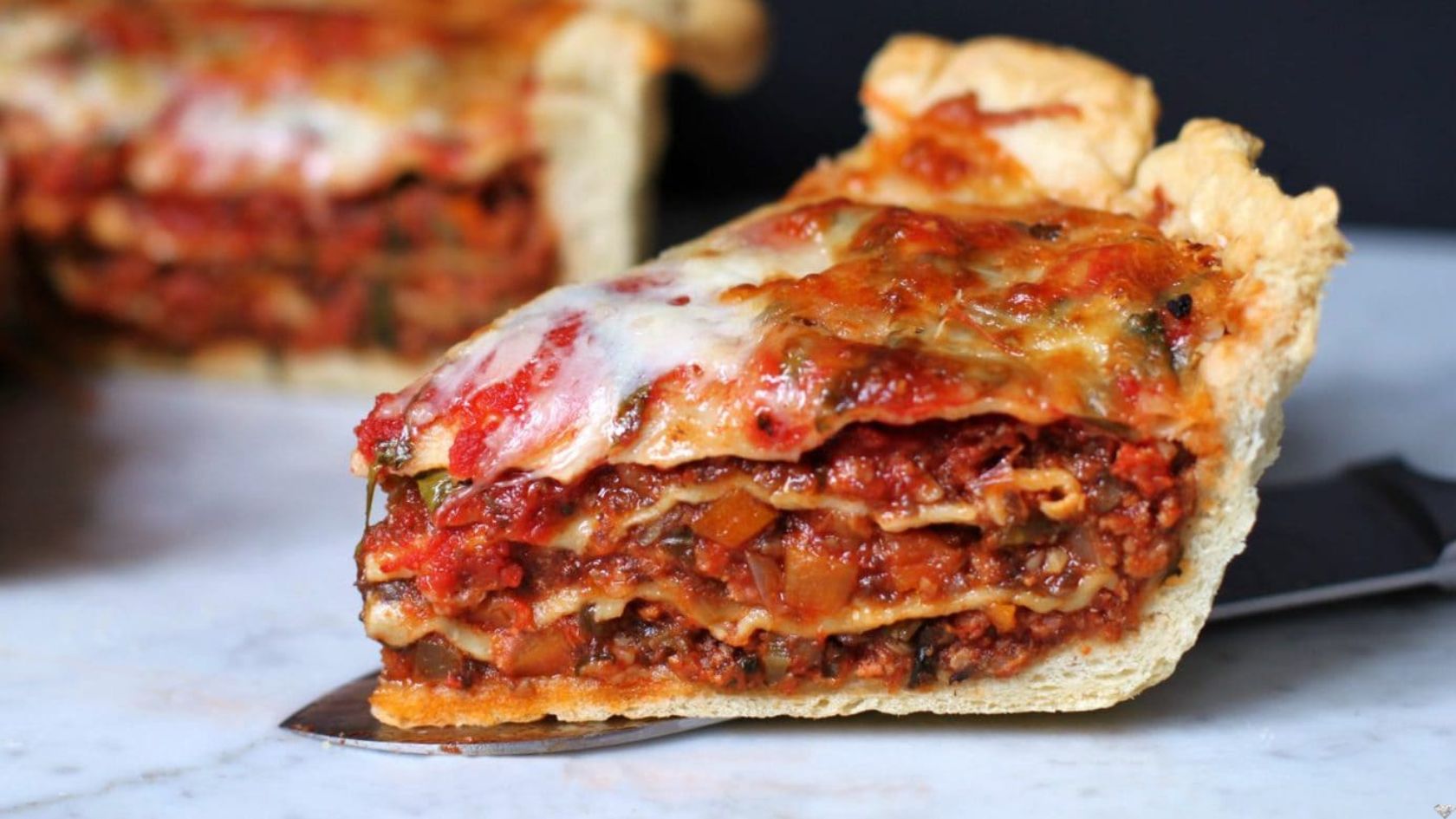Is Pizza A Pie?
Pizza has been a staple food for centuries, with its origins in Italy. Pizza is a familiar comfort food that brings back nostalgic memories for many of us. It is a favorite dish among Americans–even bringing families together on national Pizza Day. But what exactly is pizza? Is it truly classified as a pie or does it stand alone in the world of culinary dishes?
To settle this argument once and for all, let’s take a look at the history and evolution of pizzas, how they compare to other pies, and what factors make them different from traditional types of pastry. This post will help you determine where pizza stands in terms of being considered a true “pie” and answer everyone’s burning question “is pizza really just another kind of pie?” so that when deciding what desserts to indulge in on your next family outing you can make an informed decision.

What is a pizza?
A pizza is a savory dish of Italian origin, consisting of a usually round, flattened base of leavened wheat-based dough topped with tomatoes, cheese, and various other ingredients baked at a high temperature. The modern pizza was invented in Naples, Italy, and the dish has since become popular in many parts of the world. Today pizzas come in all shapes and sizes – from thin crust to deep dish – and can be made with any type of topping imaginable. Whether it’s vegetarian or meaty, spicy or mild, there’s a pizza for everyone.
Pizza is now so popular that it’s become one of America’s favorite comfort foods. It’s estimated that about 3 billion pizzas are sold in the U.S. each year! Pizza is a popular party food, great for feeding large groups of people, and can often be found at potlucks, sleepovers, birthday parties, and school functions.
Pizzas can be enjoyed from the comfort of your own home too. You don’t need to order out or wait in line – you can make delicious homemade pizzas with just about any topping that you like! With a few simple ingredients like pizza dough, sauce and cheese you have the base for an amazing meal. From there, add whatever flavors you desire – pepperoni, mushrooms, olives or onions – let your imagination run wild! Homemade pizza makes a great family dinner or a fun activity to do together.
Where does pizza come from?
Pizza has a long and interesting history. The dish originated in Naples, Italy during the 18th century and was traditionally made with simple ingredients such as tomatoes, cheese, garlic, olive oil and basil. Over time, different regions of Italy began to add their own unique toppings. For example, in Rome they added mozzarella whereas in Sicily they added anchovies. By the 19th century pizza had become popular enough that it started to spread beyond its Italian origins. Today you can find pizza almost everywhere.
Nowadays, pizza has become an international phenomenon with millions of people around the world enjoying it in different variations. The possibilities for toppings are virtually endless and you can find everything from classic pepperoni to more exotic ingredients like pineapple, clams and even chocolate! No matter what your preference is, there’s a pizza out there that will satisfy all cravings.
So whatever your favorite type of pizza might be, one thing is certain – it’s sure to please anyone who loves good food. From its humble beginnings in Naples to its worldwide popularity today, pizza continues to be a beloved dish enjoyed by people everywhere.
What is a pie?
A pie is a baked dish with a pastry crust that typically contains a filling of savory or sweet ingredients. Pies can be made in either a single-crust or double-crust form, the latter of which covers the filling completely. Popular fillings include fruit, vegetables and meat mixtures, but pies can also contain almost anything imaginable. For example, some people enjoy making sweet pies filled with chocolate, peanut butter or even ice cream!
Pies are an excellent choice for any gathering since they offer plenty of variety in both flavors and textures. They’re great for potlucks, parties and family dinners since there’s something for everyone – from classic favorites like apple pie to more inventive creations like banana cream pie. Pies can also be served as either a savory or sweet dish, making them one of the most versatile desserts around!
Whether you’re in the mood for something traditional or looking to try something new, pies are always a crowd favorite. With so many delicious options out there, you’ll never run out of ideas for your next gathering.
History of pie
Pies have a long and storied history that dates back to ancient Egypt where they were traditionally filled with honey and bird’s eggs. Pies also made their way to Europe by way of the Romans who used them as vessels for meat and fruit fillings. By the Middle Ages, pies had become popular throughout England with recipes for various types such as mincemeat pie, chicken pot pie and even strawberry pie.
Today, pies are still enjoyed just about everywhere from the United States to France to Australia. They can be served in a variety of ways – as an appetizer, snack or dessert – and come in a wide range of flavors ranging from savory to sweet. No matter what type you prefer, there’s a pie out there that’s sure to please your palate.
So whether you’re looking for something traditional or want to try something new, pies are always a tasty option that will be enjoyed by everyone at the table. With so many different varieties available, it’s easy to find one everyone will love.
What are some of the similarities between a pizza and a pie?
Both pizza and pie are beloved dishes that have been enjoyed around the world for centuries. They both make use of dough as the base of their crust, though pizza is usually thinner than a traditional pie. Both also feature toppings or fillings that can range from savory to sweet, allowing them to be served as either an appetizer, snack or dessert. Additionally, both are easy to customize with different flavors and ingredients so there’s something for everyone.
The main difference between pizza and pies is the type of dough used in each. Pizza uses a thin crust made from Italian-style bread dough while pies typically use pastry dough for their base. However, this does not mean one is necessarily better than the other – it simply depends on personal preference.
What are some of the differences between a pizza and a pie?
The main difference between a pizza and a pie is the type of dough used for their crusts.
Pizza typically uses an Italian-style bread dough while pies usually use pastry dough. Pizzas are also usually served with tomato sauce, cheese and other toppings, whereas pies usually feature a sweet or savory filling that’s covered by either a single-crust or double-crust top. Additionally, pizzas are often cut into slices while pies are typically served in wedges.
Finally, one of the biggest differences between a pizza and a pie is how they’re cooked. Most pizzas are cooked in wood-fired ovens at very high temperatures, whereas pies are generally baked in regular ovens at lower temperatures.
To make it easier to distinguish the differences between a pizza and a pie, we have a comparison detailed here.
1) Different about dough:
Pizza usually uses an Italian-style bread dough while pies usually use pastry dough.
For starters, compared to pie crust, pizza dough is often thinner and crispier. Additionally, in order to preserve the structure of the dough, pizza is baked at a greater temperature for a shorter period of time.
In contrast, a pie crust is usually made with a combination of fat and flour. It’s much thicker than pizza dough, as it needs to be able to hold its shape while baking. Additionally, because the crust isn’t meant to crisp up, pies are typically cooked at lower temperatures for longer periods of time.
2) Different about fillings:
Pizzas are usually served with tomato sauce, cheese and other toppings, whereas pies usually feature a sweet or savory filling that’s covered by either a single-crust or double-crust top. Furthermore, pizzas are often cut into slices while pies are typically served in wedges.
3) Different about cooking process:
Most pizzas are cooked in wood-fired ovens at very high temperatures, whereas pies are generally baked in regular ovens at lower temperatures. Additionally, pizza dough is often pre-baked before adding the toppings while pie crusts bake with their fillings inside.
4) Different about toppings:
Pizzas usually feature tomato sauce, cheese and other savory toppings such as vegetables or meats, whereas pies can be filled with anything from fruits and custards to curries and savory meats. Additionally, some pizzas may also feature a sweeter topping such as sugar and cinnamon, while pies can be topped with cream or ice cream.
5) Different about sauce:
Pizza is usually served with tomato sauce, while pies may not have any sauce at all. Additionally, the sauce on a pizza will generally be spicier than what’s used for pies.
6) Different about shapes:
Pizzas are typically round, but can also be rectangular or square. Pies, on the other hand, are usually baked in a pie dish and cut into wedges. Additionally, some pizzas may be folded over to form a calzone-type of shape.
7) Different about cooking way:
Most pizzas are cooked in wood-fired ovens at very high temperatures, whereas pies are generally baked in regular ovens at lower temperatures.
Overall, the differences between a pizza and a pie come down to the type of ingredients used, the way they’re cooked, and the shape they take. While both are tasty treats, they each come with their own unique flavors and textures that make them stand out from one another. By understanding the differences between pizza and pie, you can ensure that your next meal is as delicious as possible.
So, a pizza is a pie?
In general, pizza is not a pie. While both are savory dishes, they have some key differences that set them apart from one another.
Not really. While both are delectable treats that make for a great meal, there are several differences between the two that set them apart from one another. From the type of dough used to how they’re cooked and served, it’s easy to distinguish the key differences between pizza and pie. Understanding these differences can help you create or order the perfect dish for your next meal. By understanding the distinctions between a pizza and a pie, you can pick the right dish for your culinary needs.
FAQs
What is the history of the name “pizza”?
The word “pizza” is derived from the Italian word for pie, which is “pizza.” The Romans are believed to have created a flatbread-like dish known as focaccia that served as an early precursor to modern pizza. This dish was made with flour, salt and oil and cooked in wood-fired ovens. Over time, these flatbreads evolved into what we now know as pizzas. The first pizzeria opened in Naples, Italy in 1830 and since then it has been enjoyed around the world. Today, there are countless varieties of pizza available including deep dish, thin crust and Chicago-style. Regardless of the type of pizza people enjoy, they can agree on one thing: nothing beats a delicious slice of pizza.
Who refers to pizza as pie?
Most people would not consider pizza to be a pie because the two have distinct differences. Pie is typically made with a pastry crust and filled with various ingredients such as fruit or custards, while pizza typically features a thin crust with savory toppings. Additionally, pizzas are usually cut into slices while pies are served in wedges. However, some people may incorrectly refer to pizza as a pie due to the similarities between the two dishes. It is important to understand that while they share some similarities, they are separate dishes with their own unique flavors and textures.
Pizza: Does it mean pie in Italian?
No, pizza does not mean pie in Italian. As previously mentioned, the word “pizza” is derived from the Italian word for pie, which is “pizza.” However, while they are related words they do not mean the same thing. In Italian, a pie typically refers to a sweet or savory pastry dish that has a crust and filling. Pizza on the other hand refers specifically to a savory dish made with dough, sauce and cheese. Ultimately, pizza is not considered to be a type of pie in Italy or anywhere else. Although some may incorrectly refer to it as such due to its similarities to pies, it is actually its own distinct dish that has become popular around the world thanks to its delicious flavors and textures.
What other pizza names are there in the world?
Pizza is known by different names around the world in addition to its Italian origin. In France, it is referred to as “pizzas,” while in Spain it is called “pizza.” In Germany, pizza is known as a “fladenbrot” and in Greece, people refer to it as “plakounta.” Additionally, it can be found under various other names such as “pitso” in South Africa, “pizhong” in China, and “pirogi” in Russian. Regardless of the name, pizza is a beloved dish that has become popular around the world. Understanding the differences between pizza and pie can help ensure that your next meal is as delicious as possible.
What are some of the most popular pizza toppings?
Some of the most popular pizza toppings include pepperoni, mushrooms, onions, sausage, olives, and tomatoes. Other favorite toppings include pineapple, anchovies, spinach, peppers, garlic and bacon. Depending on personal preference or regional variation, there is no limit to the type of toppings that can be used on a pizza. As long as you enjoy it, any topping can make for an enjoyable meal.
Is it possible to make vegan pizzas?
Yes! It is possible to make vegan pizzas with plant-based ingredients such as cheese substitutes made from nuts or soybeans and vegetable-based toppings instead of meat. Vegan pizzas can be as flavorful and delicious as traditional pizza, and it’s a great way to enjoy an old favorite in a new way. Pizza is an incredibly versatile dish that can accommodate almost any dietary preference or food style. With its endless variations and flavor combinations, it is no wonder why pizza has become popular around the world!
What are some tips for making the perfect pizza?
Making the perfect pizza involves more than just picking your favorite toppings. For starters, using high-quality ingredients and fresh produce is essential to creating a delicious dish. Additionally, you should ensure that your oven is preheated to a temperature of at least 400°F before baking the pizza. Finally, it’s important to give the dough plenty of time to rise before forming it into a crust. With a little practice and patience, anyone can make a delicious homemade pizza!
What type of sauce is traditionally used on pizza?
Traditionally, pizzas are topped with tomato sauce or a marinara sauce which is made with tomatoes, onion, garlic, and herbs. For an extra flavorful sauce, you can also add in other ingredients such as olives or anchovies. Additionally, there are a variety of other sauces that can be used on pizza including pesto, alfredo and even barbecue sauce! Ultimately, the type of sauce you use will depend on your personal preference or the type of pizza you’re making. Experimenting with different sauces is one way to make your pizzas more exciting and delicious!
What are some creative ways to serve pizza?
Pizza doesn’t have to be limited to traditional slices cut from a large pie! There are many creative ways to serve pizza that will tantalize taste buds and bring smiles to everyone’s faces. For instance, pizza can be served in bite-size pieces on skewers or as a calzone stuffed with all your favorite toppings. Pizza cones are also popular and make for an exciting presentation. Additionally, you can even make personal pizzas inside of hollowed out bell peppers! From handheld to fancy, there is no shortage of creative ways to serve up this beloved dish.
What is the best way to store leftover pizza?
Leftover pizza should always be refrigerated within two hours of cooking. To ensure that it stays fresh for longer, wrap it in aluminum foil or place it in an airtight container before refrigerating. If stored properly, cold slices will last for up to four days in the refrigerator. Reheating pizza is easy to do and can be done quickly in the oven or microwave. Alternatively, cold slices make for a delicious snack that can be enjoyed straight from the fridge! Enjoying leftover pizza has never been easier.
Conclusion
In conclusion, pizza is not considered to be a type of pie. While they share some similarities such as their dough-based ingredients and savory toppings, they are distinct dishes with their own unique flavors and textures. Pies typically have a pastry crust and are filled with various sweet or savory ingredients while pizzas usually feature a thin crust and savory toppings. Additionally, pies are served in wedges while pizzas are cut into slices. Ultimately, understanding the key differences between pizza and pie can help you make the right decision for your next meal. Whether you’re ordering from a restaurant or making it at home, understanding these distinctions can ensure that you pick the perfect dish for your culinary needs.
References:
Grow Your Own Slice of Pizza Pie! Recommended Plants
3 Ways to Make Pizza – wikiHow
I’m Vance Douglas, and I love making pizza. In fact, I love it so much that I decided to build my own oven to make it in. It’s a brick oven that I made myself, and it’s the best pizza oven you’ll ever find.
Making pizza is a passion of mine, and I’m always looking for new ways to make it even better. I’ve been making pizza for years, and I continue to learn more about the art every day. My goal is to create the perfect pizza, and I’m getting closer and closer every time.



